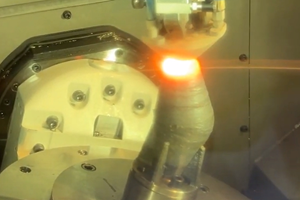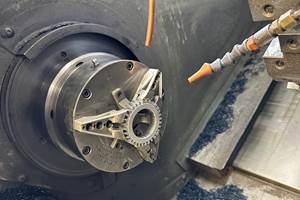Additive Manufacturing Makes Subtractive Cutting Tools
Mapal reaps the benefits of additive and subtractive manufacturing with its QTD drills.
Share






It may seem counterintuitive to produce subtractive cutting tools using additive manufacturing (AM) methods, but cutting tool manufacturer Mapal based in Aalen, Germany, found the strategy to be well-suited to expanding its line of coolant-through drills. Laser melting systems from Concept Laser enabled the company to produce its QTD drills in sizes smaller than were previously practical, opening up design options that would not otherwise be possible.
Mapal’s QTD drills with through-coolant capability are offered as an economical alternative to solid carbide drills. Each drill in this line consists of a hardened steel shank and body with a V-block mounting for the replaceable insert. According to Mapal, the through-coolant drills offer good chip deformation and reliable chip removal for drilling in steel, stainless steel, cast iron and aluminum.
Until recently, these drills were only offered in diameters of 13 mm or greater. Producing smaller drills was not possible because of the internal central coolant supply channel and Y-shaped fork that distributes coolant to either inside of the cutting insert. Reducing the size of the tool while maintaining the diameter of the coolant bore could make the drill unstable, but reducing both would limit the rate of coolant flowing to the cutting edge and decrease its effectiveness. These restrictions made it impractical to pursue a smaller drill made with the same design and methods.
Since May 2013, Mapal has been investigating how additive manufacturing, specifically selective laser melting, could alleviate challenges in producing through-coolant tooling. New, smaller QTD drills that could not have been made via traditional machining are the result of this work.
Mapal’s R&D department was able to produce QTD drills with an optimized coolant supply design using two M1 LaserCusing systems from Lichtenfels, Germany-based Concept Laser. The additive manufacturing machines use a laser to melt specific areas of metal powder held in a bed, fusing the part together layer by layer. Building up a part via laser melting enables the creation of complex geometries—including internal geometries—that would not be possible with machining.
Leveraging this technology, Mapal developed a new QTD drill that has a spiral cooling geometry with the coolant channels running parallel to the spiral of the flute, which increases the core stability and improves cooling effectiveness. According to the company, the spiral coolant routing is responsible for increasing the drills’ coolant volume flow by 60 percent.
Mapal was also able to change the cross-section of the coolant channels. Rather than the round passageways created by drilling, the laser-melted drills feature triangular channels. According to the company, the triangular passageways increase the quantity of coolant flow by as much as 30 percent over the previous drills. The combination of spiral routing and the triangular cross-section is said to increase coolant flow rate by 100 percent over the previous design.
These design improvements now allow the company to additively manufacture drill bodies smaller than 13 mm in diameter, down to 8 mm. On these small-diameter drills, Mapal uses a hybrid process whereby the tool shank is machined conventionally and then the drill body is built up in a LaserCusing machine from 1.2709 steel. The build happens in two stages; the core of the drill with the cooling system is built first, followed by an outer hull with higher density for increased hardness. Batches of 100 to 121 drill bodies can be built at one time.
This hybrid process allows Mapal to reap the benefits of speed from traditional machining in making the tool shanks, as well as the material efficiency, unattended production and design benefits of additively manufacturing the drill bodies. Rather than replacing machining, Mapal is using additive manufacturing to fill a production gap and make possible designs that could not be produced any other way.
Related Content
The Downloadable Metal 3D Printer
Copenhagen researchers introduce a fully open-source laser powder bed fusion system, now available on GitHub. This release follows their development of an open-source vat polymerization machine. Here is the purpose and promise of this philanthropically funded effort to advance additive manufacturing application and adoption.
Read MoreAdditive/Subtractive Hybrid CNC Machine Tools Continue to Make Gains (Includes Video)
The hybrid machine tool is an idea that continues to advance. Two important developments of recent years expand the possibilities for this platform.
Read MoreDigital Thread Enables First-Time-Right 3D Printing
Connecting all stages of manufacturing, from design to postprocessing, helps break down barriers to industrializing additive manufacturing.
Read MoreChuck Jaws Achieve 77% Weight Reduction Through 3D Printing
Alpha Precision Group (APG) has developed an innovative workholding design for faster spindle speeds through sinter-based additive manufacturing.
Read MoreRead Next
Last Chance! 2025 Top Shops Benchmarking Survey Still Open Through April 30
Don’t miss out! 91ÊÓƵÍøÕ¾ÎÛ's Top Shops Benchmarking Survey is still open — but not for long. This is your last chance to a receive free, customized benchmarking report that includes actionable feedback across several shopfloor and business metrics.
Read MoreMachine Shop MBA
Making Chips and 91ÊÓƵÍøÕ¾ÎÛ are teaming up for a new podcast series called Machine Shop MBA—designed to help manufacturers measure their success against the industry’s best. Through the lens of the Top Shops benchmarking program, the series explores the KPIs that set high-performing shops apart, from machine utilization and first-pass yield to employee engagement and revenue per employee.
Read MoreAMRs Are Moving Into Manufacturing: 4 Considerations for Implementation
AMRs can provide a flexible, easy-to-use automation platform so long as manufacturers choose a suitable task and prepare their facilities.
Read More.jpg;width=70;height=70;mode=crop)





















